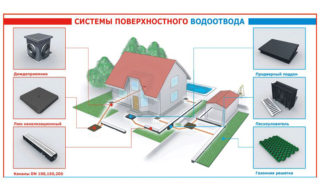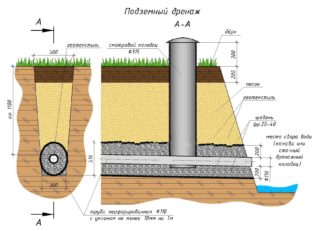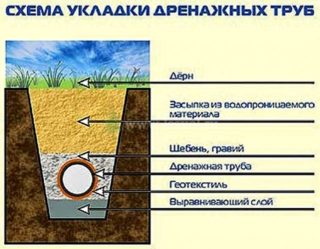If the land on the site is excessively wet, the trees on it will grow poorly, and garden crops will hurt. The abundance of moisture causes the foundation to erode. Because of this, the house and other buildings shrink, the cellar is flooded in the spring. Wet ground, freezing, rises and presses on the blind area around buildings and garden paths, which leads to their cracking. To avoid all this, it is necessary to make the correct drainage of the adjoining or suburban area.
Types and arrangement of drainage systems
To drain the area, a suitable type of drainage is used: surface or deep. The first is more often used with alumina. Only the deep method is suitable for the drainage of groundwater.
Features of surface drainage
The system can be point or linear. The first option is used to drain water from local places. Special water collectors are installed at points of moisture accumulation. Such a network is considered the most budgetary, and it does not require drawings and diagrams.
Linear drainage will bring more difficulties in the design and arrangement.
This method of drainage will help:
- remove excess moisture from buildings;
- prevent washing out of the fertile layer;
- protect the entrance to the territory, paths in the garden.
With linear drainage, a grid is designed, consisting of slightly buried drainage ditches with the required slope. They are located along the perimeter of the garden area and in areas of maximum moisture accumulation.
Soil drainage is organized not only by the open trench method, but also special drainage trays with grates are installed. A closed system looks more aesthetically pleasing, but it is more expensive and more difficult to install.
Arrangement of the deep system
As with the arrangement of a surface drainage network, it is required to form a branch channel into which moisture from all drainage pipes will be collected. It goes into a water receiver - a sewer, a pond or a well storage.
Design work
Before you install a drainage system near a private house or summer cottage with your own hands, you need to study the relief using a level and a laser rangefinder. In the absence of geodetic instruments, it is possible to establish the places of accumulation and the direction of movement of moisture after a heavy rain.
As a result, a large-scale drawing is created, which will display the depth of the trenches or the installation of drainage pipes and show their location.
When creating a project, the location of the wells for maintenance is taken into account. The pipes are installed with a slope of 2-10 mm per meter towards the water receiver.
The creation of a drainage system is associated with a significant amount of earthwork. This must be done before planting horticultural crops, or even better - before the foundation of a house or outbuildings begins.
Drainage system installation stages
The depth of the trench is 50–70 cm, the width is about 0.5 m. The ditch is dug with beveled walls with an angle of inclination of 25–30 degrees. The task becomes more complicated only when it is decided to equip the rainwater drainage system with trays.
To make a deep drainage drainage system around the house and on the site yourself, you need to systematically go through all the stages of installation:
- Dig trenches under the drainage mesh.
- Fill the bottom of the ditch with 7–10 cm thick sand mixture and tamp.
- Lay the geo-material so that it protrudes beyond the edges of the trench.
- Place a 20 cm thick cushion on top of the geotextile to filter out debris. Lime crushed stone will not work, as salt marsh may appear.
- Route pipe sections onto the rubble. When installing drainage pipes for groundwater drainage with your own hands, make sure that the perforation is directed downward.
- Fill the crushed stone layer on the pipeline and cover it with the edges of geotextile, which will filter the liquid from suspended impurities, which will not allow the system to silt.
- Bury the trenches with earth, you can lay a sod cover on top of it.
In order to monitor the drainage process and clean the system, inspection wells are arranged at the lowest points of the site. They can be assembled from concrete rings. With a drainage depth of no more than three meters, you can choose compact corrugated pipes. Structures must be fitted with covers to keep debris out.
On straight branches, the installation of revisions is carried out every 35-50 m, and at every second turn with a "broken" trench. Drainage of water from a well can be carried out into a natural reservoir, a ravine or a general storm drain.
Common mistakes
Site drainage errors can be detected as soon as the autumn rainy season begins or in the spring with floods. The main problems include:
- A slight slope, which is unable to ensure the removal of moisture from the site by gravity. All water will remain in the territory. To fix the problem, you will need to dismantle the wells and redo the trenches to the desired slope.
- Insufficient drainage from the bay of the basement or basement. It is required to install a drainage system inside the basement or around the perimeter of the foundation.
- Drainage pipes do not match the type of soil. A perforated drain will clog in clay soil and stop working. To prevent such a situation, experts advise using high-quality geotextiles.
Moisture in the area can stagnate due to one of these errors or a combination of them.
To extend the operational life of the drainage network, it is necessary to take care of it. Inspect open channels, inspection wells every two weeks from the beginning of snow melting in the spring until the arrival of winter. Prepare drainage for the spring flood, clean up clogged structures, clean up grass and bushes near trenches.
A well-designed project, properly installed installation and systematic maintenance of the drainage canals help prevent troubles caused by stagnant water on the site.











